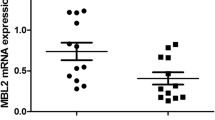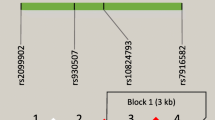Abstract
Mannose-binding lectin (MBL) encoded by MBL2 gene is a protein with the ability to form carbohydrate complexes with microbial wall promoting their subsequent elimination. Genetically determined levels of MBL can modify the risk and clinical characteristics of many infectious diseases. The frequency of MBL2 genotypes exhibits significant population differences. The data on the distribution of MBL2 genotypes among the aborigines of the Russian Arctic territories have not yet been published. A total of 880 specimens of dried blood spots of the newborns were genotyped. The newborns represented four populations: Nenets, Dolgan-Nganasans, Mixed aboriginal population, and Russians (Caucasians, Krasnoyarsk). Six polymorphisms of the MBL2 gene were studied: rs11003125, rs7096206, rs7095891, rs5030737, rs1800450, and rs1800451. The frequency of the combined rare O allele (composed of the coding region variants rs5030737, rs1800450, and rs1800451) in the homozygous state was significantly higher in Russians: 10% vs 2% in Nenets and 1% in Dolgan-Nganosans (p < 0.001 for Russians vs other populations). The frequency of the high-producing haplotype (HYPA) was 35.4% in the Russian newborns, in keeping with European populations (27–33%); 64% for Nenets and 56% for Dolgan-Nganasans, similar to the estimates obtained for Eskimos and North Amerinds (64–81%). Our study results are in line with the hypothesis that human evolution has been moving in the direction of accumulation of the genotypes associated with low activity of the lectin complement activation pathway because of the prevalence of some intracellular infections such as tuberculosis, whereby low MBL activity may have a protective effect.
Similar content being viewed by others
References
Areeshi MY, Mandal RK, Akhter N, Dar SA, Jawed A, Wahid M, Mahto H, Panda AK, Lohani M, Haque S (2016) A meta-analysis of MBL2 polymorphisms and tuberculosis risk. Sci Rep 6:35728. https://doi.org/10.1038/srep35728
Bernig T, Taylor JG, Foster CB, Staats B, Yeager M, Chanock SJ (2004) Sequence analysis of the mannose-binding lectin (MBL2) gene reveals a high degree of heterozygosity with evidence of selection. Genes & Immunity 5:461–476. https://doi.org/10.1038/sj.gene.6364116
Bernig T, Breunis W, Brouwer N, Hutchinson A, Welch R, Roos D, Kuijpers T, Chanock S (2005) An analysis of genetic variation across the MBL2 locus in Dutch Caucasians indicates that 3′ haplotypes could modify circulating levels of mannose-binding lectin. Hum Genet 118:404–415. https://doi.org/10.1007/s00439-005-0053-5
Best LG, Davidson M, North KE, MacCluer JW, Zhang Y, Lee ET, Howard BV, DeCroo S, Ferrell RE (2004) Prospective analysis of mannose-binding lectin genotypes and coronary artery disease in American Indians: the strong heart study. Circulation 109:471–475. https://doi.org/10.1161/01.CIR.0000109757.95461.10
Bjarnadottir H, Arnardottir M, Ludviksson BR (2016) Frequency and distribution of FCN2 and FCN3 functional variants among MBL2 genotypes. Immunogenetics 68:315–325. https://doi.org/10.1007/s00251-016-0903-4
Boldt ABW, Culpi L, Tsuneto LT, De Souza IR, Kun JFJ, Petzl-Erler ML (2006) Diversity of the MBL2 gene in various Brazilian populations and the case of selection at the mannose-binding lectin locus. Hum Immunol 67:722–734. https://doi.org/10.1016/j.humimm.2006.05.009
Boldt AB, Messias-Reason IJ, Meyer D, Schrago CG, Lang F, Lell B, Dietz K, Kremsner PG, Petzl-Erler M, Kun JF (2010) Phylogenetic nomenclature and evolution of mannose-binding lectin (MBL2) haplotypes. BMC Genet 11:38. https://doi.org/10.1186/1471-2156-11-38
Cao Y, Wang X, Cao Z, Wu C, Wu D, Cheng X (2018) Genetic polymorphisms of MBL2 and tuberculosis susceptibility: a meta-analysis of 22 case-control studies. Arch Med Sci 14:1212–1232. https://doi.org/10.5114/aoms.2017.65319
Chalmers JD, McHugh BJ, Doherty C, Smith MP, Govan JR, Kilpatrick DC, Hill AT (2013) Mannose-binding lectin deficiency and disease severity in non-cystic fibrosis bronchiectasis: a prospective study. Lancet Respir Med 1:224–232. https://doi.org/10.1016/S2213-2600(13)70001-8
Czerewaty M, Tarnowski M, Safranow K, Domanski L, Pawlik A (2019) Mannose binding lectin 2 gene polymorphisms in patients after renal transplantation with acute graft rejection. Transpl Immunol 54:29–37. https://doi.org/10.1016/j.trim.2019.01.004
De Miranda Santos IKF, Costa CHN, Krieger H, Feitosa MF, Zurakowski D, Fardin B, Gomes RBB, Weiner DL, Harn DA, Ezekowitz RAB, Epstein JE (2001) Mannan-binding Lectin enhances susceptibility to visceral leishmaniasis. Infect Immun 69:5212–5215. https://doi.org/10.1128/iai.69.8.5212-5215.2001
Diego A, Paulo I, Maria F, Antonio D, Guilherme T, Maria C (2007) Genotypes of the mannan-binding lectin gene and susceptibility to visceral leishmaniasis and clinical complications. J Infect Dis 195:1212–1217. https://doi.org/10.1086/512683
Eisen DP, Osthoff M (2014) If there is an evolutionary selection pressure for the high frequency of MBL2 polymorphisms, what is it? Clin Exp Immunol 176:165–171. https://doi.org/10.1111/cei.12241
Eisen DP, Dean MM, Boermeester MA, Fidler KJ, Gordon AC, Kronborg G, Kun JF, Lau YL, Payeras A, Valdimarsson H, Brett SJ, Ip WK, Mila J, Peters MJ, Saevarsdottir S, van Till JW, Hinds CJ, McBryde ES (2008) Low serum mannose-binding lectin level increases the risk of death due to pneumococcal infection. Clin Infect Dis 47:510–516. https://doi.org/10.1086/590006
Faro J, Chen Y, Jhaveri P, Oza P, Spear GT, Lint TF, Gewurz H (2007) L-Ficolin binding and lectin pathway activation by acetylated low-density lipoprotein. Clinical & Experimental Immunology 151:275–283. https://doi.org/10.1111/j.1365-2249.2007.03538.x
Ferraroni NR, Segat L, Guimaraes RL, Brandao LA, Crovella S, Constantino-Silva RN, Loja C, da Silva Duarte AJ, Grumach AS (2012) Mannose-binding lectin and MBL-associated serine protease-2 gene polymorphisms in a Brazilian population from Rio de Janeiro. Int J Immunogenet 39:32–38. https://doi.org/10.1111/j.1744-313X.2011.01052.x
Fumagalli S, Perego C, Zangari R, De Blasio D, Oggioni M, De Nigris F, Snider F, Garred P, Ferrante AM, De Simoni MG (2017) Lectin pathway of complement activation is associated with vulnerability of atherosclerotic plaques. Front Immunol 8:288. https://doi.org/10.3389/fimmu.2017.00288
Garred P, Harboe M, Oettinger T, Koch C, Svejgaard A (1994) Dual role of mannan-binding protein in infections: another case of heterosis? Eur J Immunogenet 21:125–131. https://doi.org/10.1111/j.1744-313x.1994.tb00183.x
Garred P, Honore C, Ma YJ, Munthe-Fog L, Hummelshoj T (2009) MBL2, FCN1, FCN2 and FCN3-the genes behind the initiation of the lectin pathway of complement. Mol Immunol 46:2737–2744. https://doi.org/10.1016/j.molimm.2009.05.005
Gout E, Garlatti V, Smith DF, Lacroix M, Dumestre-Pérard C, Lunardi T, Martin L, Cesbron J-Y, Arlaud GJ, Gaboriaud C, Thielens NM (2010) Carbohydrate recognition properties of human ficolins. J Biol Chem 285:6612–6622. https://doi.org/10.1074/jbc.m109.065854
Hegele RA, Busch CP, Young TK, Connelly PW, Cao H (1999) Mannose-binding lectin gene variation and cardiovascular disease in Canadian Inuit. Clin Chem 45:1283–1285
Hoal-Van Helden EG, Epstein J, Victor TC, Hon D, Lewis L-A, Beyers N, Zurakowski D, Ezekowitz RAB, Van Helden PD (1999) Mannose-binding protein B allele confers protection against tuberculous meningitis. Pediatr Res 45:459–464. https://doi.org/10.1203/00006450-199904010-00002
Howard M, Farrar CA, Sacks SH (2018) Structural and functional diversity of collectins and ficolins and their relationship to disease. Semin Immunopathol 40:75–85. https://doi.org/10.1007/s00281-017-0642-0
Kilpatrick D (2002) Mannan-binding lectin: clinical significance and applications. Biochim Biophys Acta Gen Subj 1572:401–413. https://doi.org/10.1016/s0304-4165(02)00321-5
Luo J, Xu F, Lu GJ, Lin HC, Feng ZC (2014) Low mannose-binding lectin (MBL) levels and MBL genetic polymorphisms associated with the risk of neonatal sepsis: an updated meta-analysis. Early Hum Dev 90:557–564. https://doi.org/10.1016/j.earlhumdev.2014.07.007
Madsen HO, Garred P, Thiel S, Kurtzhals JA, Lamm LU, Ryder LP, Svejgaard A (1995) Interplay between promoter and structural gene variants control basal serum level of mannan-binding protein. J Immunol 155:3013–3020
Madsen HO, Satz ML, Hogh B, Svejgaard A, Garred P (1998) Different molecular events result in low protein levels of mannan-binding lectin in populations from Southeast Africa and South America. J Immunol 161:3169–3175
Monsey L, Best LG, Zhu J, DeCroo S, Anderson MZ (2019) The association of mannose binding lectin genotype and immune response to chlamydia pneumoniae: the strong heart study. PLoS One 14:e0210640. https://doi.org/10.1371/journal.pone.0210640
Seyfarth J, Garred P, Madsen HO (2005) The ‘involution’ of mannose-binding lectin. Hum Mol Genet 14:2859–2869. https://doi.org/10.1093/hmg/ddi318
Skalnikova H, Freiberger T, Chumchalova J, Grombirikova H, Sediva A (2004) Cost-effective genotyping of human MBL2 gene mutations using multiplex PCR. J Immunol Methods 295:139–147. https://doi.org/10.1016/j.jim.2004.10.007
Smolnikova MV, Freidin MB, Tereshchenko SY (2017) The prevalence of the variants of the L-ficolin gene (FCN2) in the arctic populations of East Siberia. Immunogenetics 69:409–413. https://doi.org/10.1007/s00251-017-0984-8
Steffensen R, Thiel S, Varming K, Jersild C, Jensenius JC (2000) Detection of structural gene mutations and promoter polymorphisms in the mannan-binding lectin (MBL) gene by polymerase chain reaction with sequence-specific primers. J Immunol Methods 241:33–42. https://doi.org/10.1016/s0022-1759(00)00198-8
Sullivan KE, Wooten C, Goldman D, Petri M (1996) Mannose-binding protein genetic polymorphisms in black patients with systemic lupus erythematosus. Arthritis Rheum 39:2046–2051. https://doi.org/10.1002/art.1780391214
Tereshchenko SY, Kasparov EV, Smol'Nikova MV, Kuvshinova EV (2016) Mannose-binding lectin deficiency in respiratory diseases. Russian Pulmonology 26:748-752. https://doi.org/10.18093/0869-0189-2016-26-6-748-752
Tong X, Wan Q, Li Z, Liu S, Huang J, Wu M, Fan H (2019) Association between the mannose-binding lectin (MBL)-2 gene variants and serum MBL with pulmonary tuberculosis: an update meta-analysis and systematic review. Microb Pathog 132:374–380. https://doi.org/10.1016/j.micpath.2019.04.023
Troldborg A, Hansen A, Hansen SW, Jensenius JC, Stengaard-Pedersen K, Thiel S (2017) Lectin complement pathway proteins in healthy individuals. Clin Exp Immunol 188:138–147. https://doi.org/10.1111/cei.12909
Valles X, Sarrias MR, Casals F, Farnos M, Piner R, Suarez B, Morais L, Mandomando I, Sigauque B, Roca A, Alonso PL, Torres A, Thielens NM, Lozano F (2009) Genetic and structural analysis of MBL2 and MASP2 polymorphisms in south-eastern African children. Tissue Antigens 74:298–307. https://doi.org/10.1111/j.1399-0039.2009.01328.x
Van Kempen G, Meijvis S, Endeman H, Vlaminckx B, Meek B, De Jong B, Rijkers G, Bos WJ (2017) Mannose-binding lectin andl-ficolin polymorphisms in patients with community-acquired pneumonia caused by intracellular pathogens. Immunology 151:81–88. https://doi.org/10.1111/imm.12705
Verdu P, Barreiro LB, Patin E, Gessain A, Cassar O, Kidd JR, Kidd KK, Behar DM, Froment A, Heyer E, Sica L, Casanova JL, Abel L, Quintana-Murci L (2006) Evolutionary insights into the high worldwide prevalence of MBL2 deficiency alleles. Hum Mol Genet 15:2650–2658. https://doi.org/10.1093/hmg/ddl193
Wallis R, Lynch NJ (2007) Biochemistry and genetics of the collectins. In: Kilpatrick D (ed) Collagen-related lectins in innate immunity. Trivandrum, Research Signpost, pp 33–56
Zelensky AN, Gready JE (2005) The C-type lectin-like domain superfamily. FEBS J 272:6179–6217. https://doi.org/10.1111/j.1742-4658.2005.05031.x
Zhang JX, Gong WP, Zhu DL, An HR, Yang YR, Liang Y, Wang J, Tang J, Zhao WG, Wu XQ (2020) Mannose-binding lectin 2 gene polymorphisms and their association with tuberculosis in a Chinese population. Infect Dis Poverty 9:46. https://doi.org/10.1186/s40249-020-00664-9
Funding
This study was carried out under the state assignment (theme # 003) for Scientific Research Institute of Medical Problems of the North, Krasnoyarsk, Russia.
Author information
Authors and Affiliations
Contributions
ST designed and coordinated the study. MS performed the genotyping. ST, MS, and MF performed the data analysis and drafted the manuscript. All authors commented on the manuscript and agreed on the final version to be published.
Corresponding author
Ethics declarations
Conflict of interest
The authors declare that they have no conflict of interest.
Ethics approval
The study was approved by the Ethical Committee of the Scientific Research Institute of Medical Problems of the North (# 9 of 8.09.2014).
Consent to participate
Signed informed consent was obtained from parents of all participated children.
Consent for publication
Signed informed consent was obtained from parents of all participated children.
Code availability
Available at https://datadryad.org/stash/dataset/doi:10.5061/dryad.15dv41nvd, https://datadryad.org/stash/share/eAgaS5gub5TdmsSDJP8YKFXIzuoVR9NXw6cxeVxr0FE
Additional information
Publisher’s note
Springer Nature remains neutral with regard to jurisdictional claims in published maps and institutional affiliations.
Rights and permissions
About this article
Cite this article
Tereshchenko, S.Y., Smolnikova, M.V. & Freidin, M.B. Mannose-binding lectin gene polymorphisms in the East Siberia and Russian Arctic populations. Immunogenetics 72, 347–354 (2020). https://doi.org/10.1007/s00251-020-01175-5
Received:
Accepted:
Published:
Issue Date:
DOI: https://doi.org/10.1007/s00251-020-01175-5




